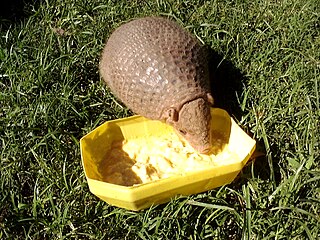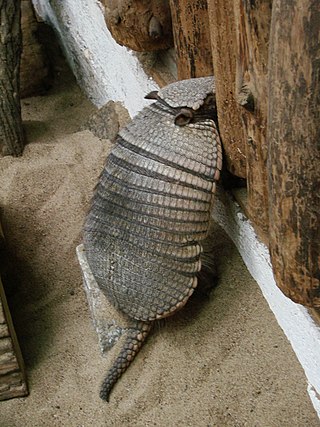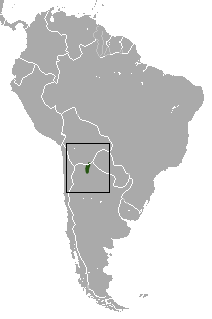
Armadillos are New World placental mammals in the order Cingulata. They form part of the superorder Xenarthra, along with the anteaters and sloths. 21 extant species of armadillo have been described, some of which are distinguished by the number of bands on their armor. All species are native to the Americas, where they inhabit a variety of different environments.

Xenarthra is a major clade of placental mammals native to the Americas. There are 31 living species: the anteaters, tree sloths, and armadillos. Extinct xenarthrans include the glyptodonts, pampatheres and ground sloths. Xenarthrans originated in South America during the late Paleocene about 60 million years ago. They evolved and diversified extensively in South America during the continent's long period of isolation in the early to mid Cenozoic Era. They spread to the Antilles by the early Miocene and, starting about 3 million years ago, spread to Central and North America as part of the Great American Interchange. Nearly all of the formerly abundant megafaunal xenarthrans became extinct at the end of the Pleistocene.

The giant armadillo, colloquially tatu-canastra, tatou, ocarro or tatú carreta, is the largest living species of armadillo. It lives in South America, ranging throughout as far south as northern Argentina. This species is considered vulnerable to extinction.

The six-banded armadillo, also known as the yellow armadillo, is an armadillo found in South America. The sole extant member of its genus, it was first described by Swedish zoologist Carl Linnaeus in 1758. The six-banded armadillo is typically between 40 and 50 centimeters in head-and-body length, and weighs 3.2 to 6.5 kilograms. The carapace is pale yellow to reddish brown, marked by scales of equal length, and scantily covered by buff to white bristle-like hairs. The forefeet have five distinct toes, each with moderately developed claws.

The seven-banded armadillo, also known as the Brazilian lesser long-nosed armadillo, is a species of armadillo from South America found in Paraguay, Argentina, Bolivia and Brazil. It is a solitary nocturnal, terrestrial animal, living mostly in dry habitats, outside of rainforest regions.

The southern long-nosed armadillo is a species of armadillo native to South America.

The Andean hairy armadillo is an armadillo found mainly in Bolivia, in the region of the Puna; the departments of Oruro, La Paz, and Cochabamba. Nowark (1991) describes it as distributed in Bolivia and northern Chile. A recent publication of Pacheco (1995) also locates the species in the Puno Region of Peru. This species is also thought to be present in northern Argentina. However, this location may actually only contain a population of C. vellerosus.

The pichi, dwarf armadillo or pygmy armadillo is an armadillo native to Argentina. It is the only living member of the genus Zaedyus, and the only armadillo to hibernate. Fossil remains from the Cerro Azul Formation indicate this species had already evolved during the late Miocene epoch.

The Chacoan naked-tailed armadillo is a species of South American armadillo.

Chaetophractus is a small genus of armadillos in the family Chlamyphoridae. It contains the following three species:

The bighairy armadillo is one of the largest and most numerous armadillos in South America. It lives from sea level to altitudes of up to 1,300 meters across the southern portion of South America, and can be found in grasslands, forests, and savannahs, and has even started claiming agricultural areas as its home. It is an accomplished digger and spends most of its time below ground. It makes both temporary and long-term burrows, depending on its food source. In Spanish it is colloquially known as "peludo".

The hairy long-nosed armadillo or woolly armadillo is a species of armadillo in the family Dasypodidae. It is endemic to Peru. Its natural habitats are subtropical or tropical moist lowland forest and subtropical or tropical moist montane forest. The International Union for Conservation of Nature used to consider it a "vulnerable species" but has changed this assessment to "data deficient" because so little is known about the animal and the threats it faces.

Pampatheriidae is an extinct family of large cingulates related to armadillos. They first appeared in South America during the mid-Miocene, and Holmesina and Pampatherium spread to North America during the Pleistocene after the formation of the Isthmus of Panama as part of the Great American Interchange. They became extinct as part of the end-Pleistocene extinctions, about 12,000 years ago.

The Llanos long-nosed armadillo or northern long-nosed armadillo is a species of armadillo in the family Dasypodidae. It is endemic to Colombia and Venezuela, where its habitat is the intermittently flooded grassland of the Llanos. The species is closely related to the nine-banded armadillo and the great long-nosed armadillo. It has very little hair and can weigh up to 22 pounds (9.5 kg), and can grow to about 2.1 feet (60 cm) long. It lives in dense cover near limestone formations. Like most other armadillos, it eats ants.

Stegotherium is an extinct genus of long-nosed armadillo, belonging to the Dasypodidae family alongside the nine-banded armadillo. It is currently the only genus recognized as a member of the tribe Stegotheriini. It lived during the Early Miocene of Patagonia and was found in Colhuehuapian rocks from the Sarmiento Formation, Santacrucian rocks from the Santa Cruz Formation, and potentially also in Colloncuran rocks from the Middle Miocene Collón Curá Formation. Its strange, almost toothless and elongated skull indicates a specialization for myrmecophagy, the eating of ants, unique among the order Cingulata, which includes pampatheres, glyptodonts and all the extant species of armadillos.

Chlamyphoridae is a family of cingulate mammals. While glyptodonts have traditionally been considered stem-group cingulates outside the group that contains modern armadillos, there had been speculation that the extant family Dasypodidae could be paraphyletic based on morphological evidence. In 2016, an analysis of Doedicurus mtDNA found it was, in fact, nested within the modern armadillos as the sister group of a clade consisting of Chlamyphorinae and Tolypeutinae. For this reason, all extant armadillos but Dasypus were relocated to a new family.
Dasypus neogaeus is an extinct species of armadillo, belonging to the genus Dasypus, alongside the modern nine-banded armadillo. The only known fossil is a single osteoderm, though it has been lost, that was found in the Late Miocene strata of Argentina.

Peltephilidae is a family of South American cingulates (armadillos) that lived for over 40 million years, but peaked in diversity towards the end of the Oligocene and beginning of the Miocene in what is now Argentina. They were exclusive to South America due to its geographic isolation at the time, one of many of the continent's strange endemic families. Peltephilids are one of the earliest known cingulates, diverging from the rest of Cingulata in the Early Eocene.
The East Amazonian long-nosed armadillo is a species of armadillo found in the jungles between the Amazon, Madeira, and Madre de Dios rivers in northern Brazil and Bolivia.


















